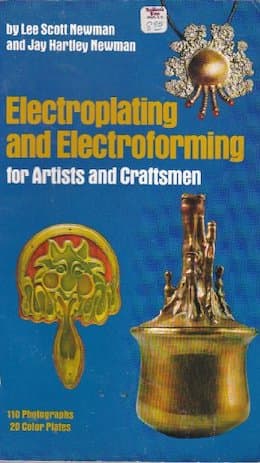
-----
Lighting manufacturer wants to copper electroform organic items
2004
I have come across the process of electroforming as a way of turning organic items such as leaves and branches into metal (copper) components to be used in my light fixtures.
by Jay H. Newman

on eBay or Amazon
or AbeBooks
(affil link)
I looked into metal stamping as a method of producing components but at this stage it is too costly to have the large number of dies needed made. Electroforming with copper seems like a straightforward process from what I've read on the internet. I'm looking to electroform to a thickness equivalent to 20-22 gauge steel. Could electroforming be the answer to my prayers? I have a few questions I was hoping you might have answers for. How much does a basic set up cost? What happens to the organic piece inside the metal plating? I need to make many pieces and understand that the process is time consuming - how is that handled in a production setting? How large an item can be electroformed? How toxic are the chemicals involved when using copper? Would the finished pieces be hard? It's a funny question but I'm asking because I don't want the applied paint finish to chip off. I've covered lots of questions and concerns and would really appreciate any help you have to offer.
With thanks,
Lisa Williamslighting manufacturer - Schomberg, Ontario, Canada
2004
Electroforming is used when you want to microscopically replicate the exterior surface of an object and produce a "negative" surface (like a mold). The electroform shell is normally separated from its "pattern", in your case the natural object. If the object is made of wax, both electroform and object are heated and the wax flows out. If you apply a plating to the outside of a branch, the more thickness you apply the more the external aspect of the electroform will be distorted. Only the INTERIOR of the electroform keeps identical to the pattern (as long as it is not separated prematurely). If a "positive" is desired, a second electroforming step has to be done with the first electroform as new pattern, thus creating a second generation to the original shape (too messy). Consider lost wax process instead.
Guillermo MarrufoMonterrey, NL, Mexico
Your suggestion may be the best one, Guillermo, but it's not exactly true that electroforming is only for replicating an object with only one significant side like a mold. Screens, foils, metal bellows, wave guides, hollow gold jewelry and other 3-dimensional objects are built by electroforming. True, the "solution side" of the electroform will not have the microscopically faithful reproduction of the mandrel side, but it can be a functional surface for many purposes.

Ted Mooney, P.E.
Striving to live Aloha
finishing.com - Pine Beach, New Jersey
Ted is available for instant help
or longer-term assistance.
2004
I agree with you, Ted. My intention was to give her an idea of how the plating will proceed and what to expect, not to exclude possibilities. There are indeed many products for which electroforming produces an acceptable outer surface but in most of these cases the mandrel is accurately engineered and processed, the electrolyte accurately controlled and the thickness limited to provide the best possible outer finish. The characteristics of a natural object such as a branch, and specially the thickness she wants, I guess make electroforming a less suitable candidate.
Best regards,
Guillermo MarrufoMonterrey, NL, Mexico
2004
Q, A, or Comment on THIS thread -or- Start a NEW Thread
